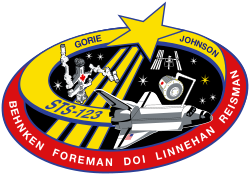Michael Foreman
| Michael Foreman | |
|---|---|
 | |
| NASA Astronaut | |
| Statsborger | USA |
| Nationalitet | Amerikansk |
| Status | Aktiv |
| Født | 29. marts 1959 Alder 65 Columbus, Ohio |
Andet arbejde | Testpilot |
| Uddannelses- sted | United States Naval Test Pilot School Naval Postgraduate School United States Naval Academy Wadsworth High School |
| Rang | Kommandør US Navy |
| Udvælgelse | NASA-gruppen fra 1998 |
| Mission(er) | STS-123 STS-400 næste mission. |
| Missionsemblemer | |
Michael James Foreman (født 29. marts 1957) er en NASA-astronaut, han har fløjet en rumfærgemission; STS-123 som missionsspecialist.
Michael Foreman er på standby til redningsmissionen STS-400.
Eksterne henvisninger
- NASA Biografi af Michael Foreman (engelsk)
- interview Arkiveret 13. marts 2008 hos Wayback Machine (engelsk)
| Spire Denne biografi om en amerikaner er en spire som bør udbygges. Du er velkommen til at hjælpe Wikipedia ved at udvide den. |
Medier brugt på denne side
STS-123 continues assembly of the International Space Station (ISS). The primary mission objectives include rotating an expedition crew member and installing both the first component of the Japanese Experimental Module (the Experimental Logistics Module - Pressurized Section (ELM-PS)) and the Canadian Special Purpose Dexterous Manipulator (SPDM). In addition, STS-123 will deliver various spare ISS components and leave behind the sensor boom used for inspecting the shuttle's thermal protection system. A follow-on mission to ISS will utilize and then return home with this sensor boom. A total of five spacewalks are planned to accomplish these tasks. The mission will also require the use of both the shuttle and ISS robotic arms. STS-123 will utilize the Station-Shuttle Power Transfer System to extend the docked portion of the mission to eleven days, with a total planned duration of 15 days. The crew patch depicts the space shuttle in orbit with the crew names trailing behind. STS-123's major additions to ISS (the ELM-PS installation with the shuttle robotic arm and the fully constructed SPDM) are both illustrated. The ISS is shown in the configuration that the STS-123 crew will encounter when they arrive.



